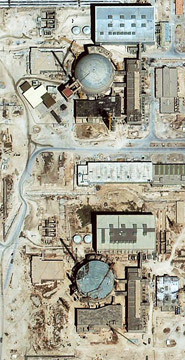
An Arial View of Iran's Bushehr Nuclear Power Plant. Credit: Times of London.
Recent events have shown Iran’s rising clout in the Middle East. Despite its economic losses stemming from reduced oil prices and increased international sanctions, Iran has been posturing itself for an increased regional role for quite some time. The controversial and firebrand President Mahmoud Ahmadinejad has been outspoken in his challenges to the West, his insistence on developing a homegrown nuclear program, and in his extensive foreign policy agenda, ranging from talks with the Gulf Cooperation Council, economic deals with Venezuela, greater dialogue with Caspian Sea nations, and promotion of the Iran-Pakistan-India pipeline. Under Ahmadinejad, Iran has increased its international scope and has gained a good deal of global notoriety.
Iran might not be on the “rising power” level of the BRIC nations, but its increased influence cannot be ignored. Central to its plans to gain power is its nuclear program. Tehran has said time and time again that it wants to develop a civilian nuclear program. But its often confusing and controversial dealings with the International Atomic Energy Association (IAEA) have given the West and other nations good reason for skepticism that Iran is seeking nuclear weapons. The reason why many experts and policy makers are concerned about Iran obtaining a nuclear weapon goes beyond the fact that Tehran and Washington are enemies. Currently, Israel is the only nuclear power in the Middle East (even though it does not officially have nuclear weapons and has never signed the Non-Proliferation Treaty). If another nation, like Iran, were to obtain a nuclear weapon, it would throw off the entire balance of power in the region and could be the spark of a massive world crisis.
Does Iran have more bark than bite, or is it a dangerous power to be reckoned with, as has been suggested by Israeli Defense Minister Ehud Barak? Israel takes the issue very seriously. Some suggest that the Mossad have a plan to prevent Iran from going nuclear. This week’s successful testing of the Bushehr nuclear power plant by Iranian and Russian officials (Russia helped build the plant and supply the required nuclear matter) added more coals to the fire. For now, it seems that the Obama administration will keep on Israel’s side and at least give lip service to the idea of preventing the Iranian program. At the UN yesterday, US Ambassador Susan Rice announced that the Obama administration’s goal is to end Iran’s mission for “illicit nuclear capacity”.
So how long will it take for Iran to go nuclear? Well, there is a big difference between having a civilian nuclear program and a nuclear weapons program. Some experts say that Iran could have its Bushehr plant functional by the end of 2009. What is unclear is whether the material for the plant would be provided by the Russians, or if the enriched uranium would come from Iranian centrifuges at the controversial Natanz facility. Even if Natanz is able to provide enriched uranium, it would take a lot more technology, investment, and time to enrich the uranium to weapons-grade quality. For more information, read Richard Bennett’s “reality check” on Iran in the Asia Times.